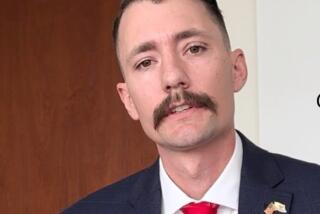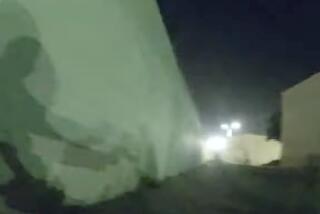Sheriff Defends Use of Flares to End Standoff
- Share via
Los Angeles County sheriff’s deputies ended a shootout with a barricaded murder suspect by tossing burning road flares into his desert hide-out, sparking a blaze last year that contributed to his death.
Sheriff Lee Baca said the tactic of setting fire to a shed to drive the suspect out was “unorthodox.” But the action was justified, Baca said, because the man was “using deadly assault weapons against us.”
Authorities had been trying to force the surrender of Donald Kueck, an unemployed drug addict with a criminal record dating back to the 1990s. He had admitted that day to killing a deputy a week before and had fired repeatedly at officers during an eight-hour standoff in a remote section of the Antelope Valley.
“If I decided to ... take a bazooka and run that round right into that shed, it would be totally justified,” Baca said.
Kueck was responsible for his own death, Baca said. “If the flare is causing a fire,” he said, “he should get out.”
But the propriety of using burning flares to flush out Kueck is being reviewed by the Los Angeles County district attorney’s office, the sheriff’s Homicide Bureau and the department’s Bureau of Internal Affairs. None of those agencies would comment.
Kueck, 52, died of “multiple firearms wounds with other significant conditions as probable effects from thermal burns,” according to the Los Angeles County coroner’s office. His charred remains were found inside a burned-out structure.
Ramona Ripston, head of the Southern California chapter of the American Civil Liberties Union, said that using fire on a suspect was outside the bounds of proper law enforcement.
“Police are supposed to apprehend suspects, not deliver the punishment,” Ripston said. “The house was surrounded. In this case, they were taking justice into their own hands, and it was rogue justice.”
Tactical policing experts and academics said the tactic surprised them.
“I can’t fathom someone having said that the best way to solve this problem is using road flares,” said Bob Louden, a professor and director of the Criminal Justice Center at John Jay College and consultant to the New York Police Department’s hostage negotiation and SWAT teams.
“They’ve got a very good tactical reputation, and it’s surprising that an organization that is that big and has been involved in police tactics as long as they have would get involved in that,” he said.
Steve Ijames, a major with the Springfield, Mo., Police Department and a SWAT expert, said he had never heard of any police department trying to drive out a barricaded suspect with fire.
“It was an utterly reckless assault,” said Samuel Walker, professor of criminal justice at the University of Nebraska and an expert on use-of-force issues.
“I don’t believe flares are an approved form of force in any law enforcement agency. It seems they could have waited him out. There were no innocent persons there,” Walker said. “What was their rush there? That is the question. It seems the emotions of the deputy’s killing may have gotten to them.”
Baca could cite no authority for the use of flares or fire.
“I don’t have an expert that would say, ‘Do this.’ I don’t have anything in our script, in our training, in the things we engage in tactically,” Baca said. “We never trained for a circumstance in the High Desert of this magnitude with someone with so much firepower in an open space.”
The fatal showdown began on the morning of Aug. 8. An informant led authorities to a home and a cluster of small buildings where Kueck was staying. It was a short distance from where Kueck had shot Deputy Stephen D. Sorensen 14 times and then had dragged the body behind his car for nearly half a mile.
Four dozen heavily armed deputies arrived, and officials told Kueck that he had to give up by sundown.
Kueck admitted shooting Sorenson, said Kueck’s stepdaughter, Becky Welch. She sat next to the police negotiator who spoke by telephone with Kueck. Over several hours that afternoon, Welch said, Kueck vacillated between giving up and vowing not to be taken alive.
Investigators looking into the standoff first questioned whether the negotiator was given enough time to persuade Kueck to surrender. Baca said at a news conference during the standoff that Kueck was going to be taken “dead or alive.”
At 7 p.m., deputies tried to flush him out with a battering ram borrowed from the Los Angeles Police Department. When that failed, they shot tear gas into Kueck’s hide-out. He still refused to surrender, and continued to shoot at deputies.
At twilight, deputies in charge made the decision to throw road flares, hoping that fire would drive Kueck out, said Michael Gennaco, head of the Office of Independent Review, the watchdog agency for the Sheriff’s Department that also is reviewing the incident.
Gennaco said his attorneys were reviewing evidence, including taped interviews with deputies at the scene. His probe was focusing on the use of tear gas, guns and the flares, he said.
Baca would not say whether he would have ordered the flares. But, he said: “Had we hit him with a round and killed him, we wouldn’t have this discussion.”
More to Read
Sign up for Essential California
The most important California stories and recommendations in your inbox every morning.
You may occasionally receive promotional content from the Los Angeles Times.











